
This roast chicken is as close as we’ve come to that terrific pollo a la brasa at your local Peruvian joint—you know, the place that has those enormous spits crammed full of chickens that they serve with the crazy addictive green sauce in those teensy plastic thimbles. Except this recipe comes minus the long wait in line.

Why Our Testers Loved This
Each of our testers who tried this Peruvian chicken recipe raved about it, including Melissa Maedgen, who had this to say: “The chicken came out juicy and nicely seasoned. The sauce is so versatile, I’d recommend going ahead and making a double batch, as you’ll want to try it on everything.”
Notes on Ingredients
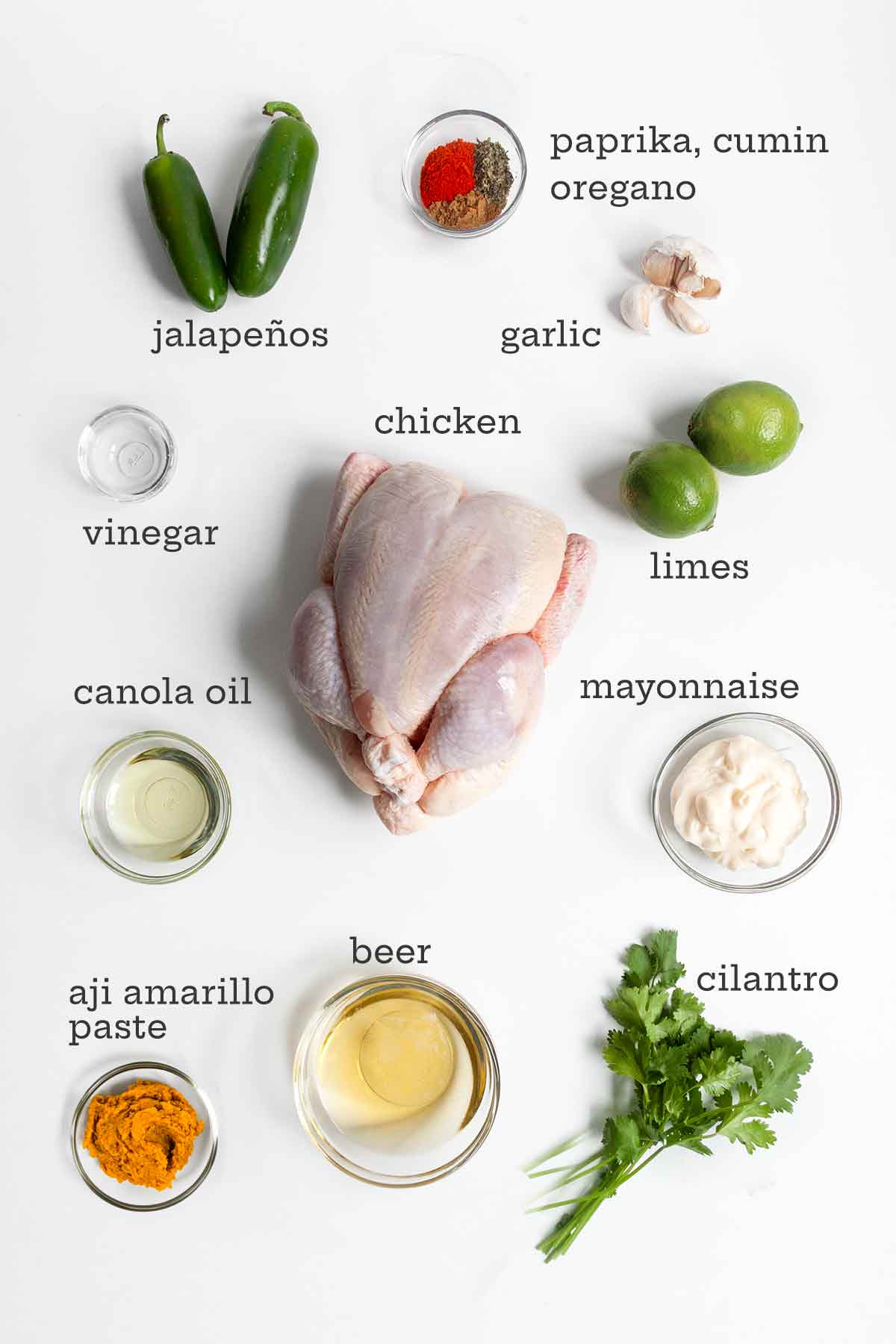
- Beer–Use a pale ale or lager for the marinade. To make gluten-free Peruvian chicken, substitute gluten-free beer.
- Chicken–You’ll need to cut your chicken into pieces or have your butcher break down the chicken for you. Alternatively, you can purchase bone-in breast and leg pieces.
- Aji amarillo paste–This paste is a popular Peruvian ingredient made from ground fresh aji amarillo chiles. It is available at Latin markets, or you can purchase aji amarillo online. If you can’t find it, substitute an additional jalapeño pepper in the sauce.
- Jalapeño–You can adjust the heat level in your sauce by keeping or removing the seeds and membranes of the peppers. Removing them will make the sauce milder and less spicy.
How to Make This Recipe
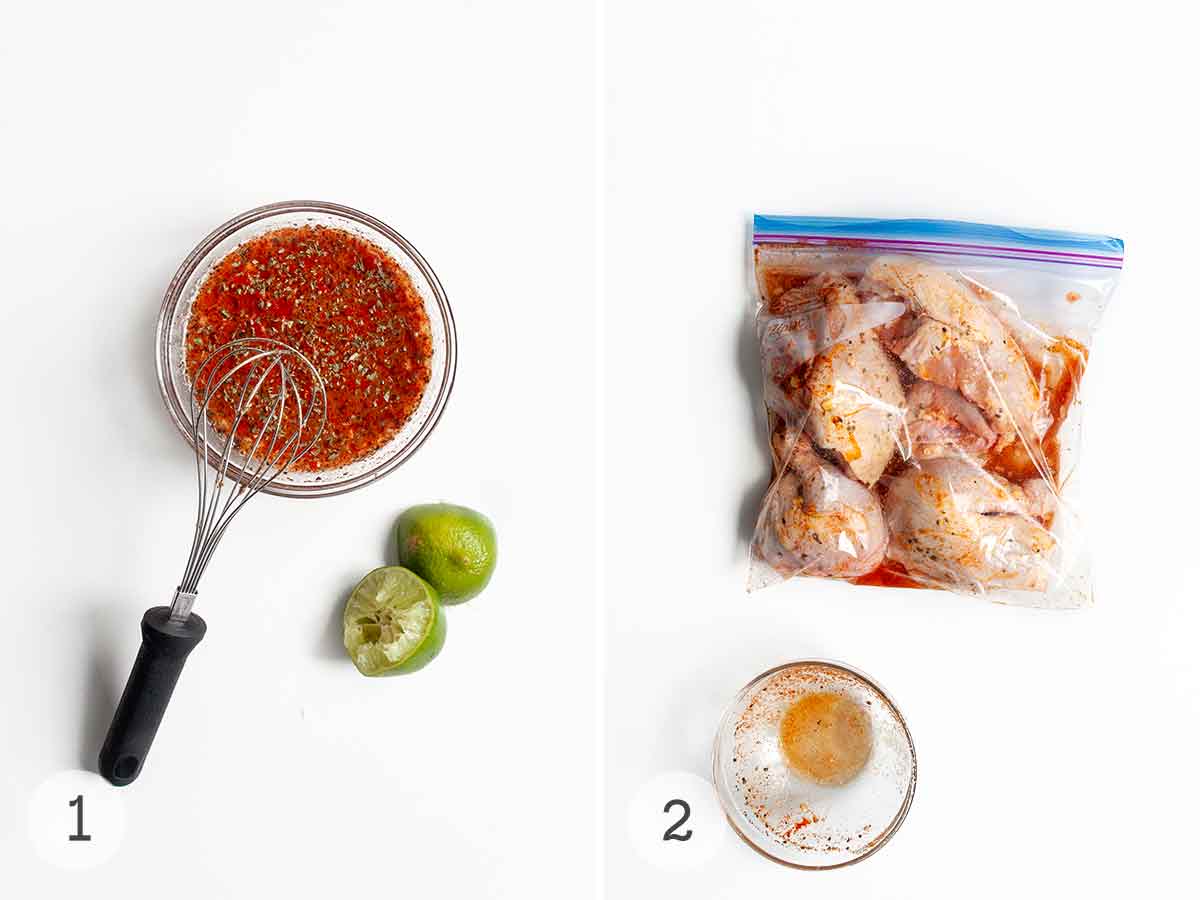
- Whisk the Peruvian chicken marinade ingredients together in a bowl.
- Tuck the chicken into a resealable bag, pour the marinade over, and zip the bag closed. Marinate the chicken in the refrigerator for 12 to 24 hours.

- Remove the chicken from the marinade and pat it dry. Roast the chicken at 425°F until cooked to an internal temperature of 165°F.
- Blitz the sauce ingredients in a blender until smooth. Serve the roast chicken with the sauce.
Common Questions
It’s a popular recipe for marinated chicken that originated in Peru. The chicken is marinated in a blend of spices, including paprika, cumin, and oregano. After marinating, the chicken is typically slow-roasted on a rotisserie, but many variations exist for oven-roasting and grilling the chicken.
It’s traditionally served with a creamy, spicy green sauce called aji verde.
Aji verde is a popular spicy Peruvian condiment made from aji amarillo chiles, which are native to Peru. The chiles are blended with garlic, cilantro, lime juice, and mayonnaise to create a smooth, creamy sauce.
Use it anywhere you want a creamy, spicy sauce to dribble and drizzle. We’re talking French fries, rice, tacos, baked eggs, grilled hanger steak, crispy smashed potatoes—name it, and you can rest assured that the creamy green sauce will be spectacular with it.
In Peru, the chicken is commonly served with fries, rice, and plantains, but you could also serve it with cool, crunchy salads, like this smashed cucumber salad or grilled vegetables.
Pro Tips
- The green sauce (aji verde) can be prepared up to 1 week before use. Store it in a sealed container or jar in the fridge.
- Don’t crowd the chicken pieces in the roasting pan or baking sheet. Giving them plenty of space to roast will result in plenty of crispy skin–which everyone loves!
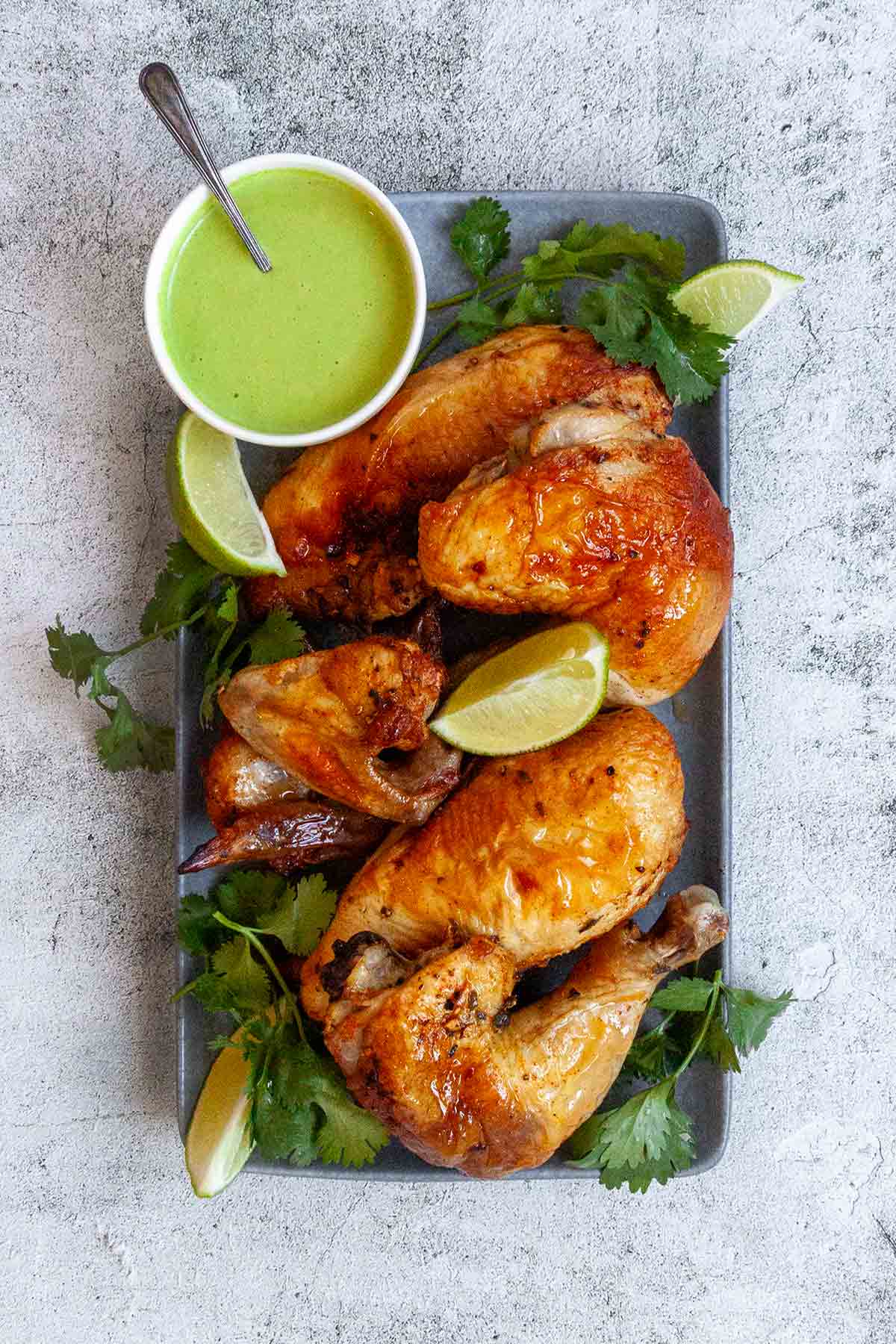
Write a Review
If you make this recipe, or any dish on LC, consider leaving a review, a star rating, and your best photo in the comments below. I love hearing from you.–David
I’ve made this recipe three times already, and my family loves it. The only trick for me is remembering to marinate the chicken the night before. The green sauce is good on everything!
Lesley

Peruvian Chicken
Ingredients
For the chicken marinade
- 1/2 cup beer, (preferably a pilsner or an ale)
- 4 cloves garlic, minced
- 2 tablespoons fresh lime juice
- 2 tablespoons canola oil
- 2 teaspoons kosher salt
- 2 teaspoons ground paprika
- 1 teaspoon cumin
- 3/4 teaspoon dried oregano, preferably Mexican
- 1/2 teaspoon freshly ground pepper
- One (3 1/2-pound) chicken, cut into pieces
For the sauce
- 2 fresh jalapenos, including seeds and ribs, roughly chopped
- 1 tablespoon aji amarillo paste, (or substitute 1 jalapeño)
- 1 cup cilantro leaves, roughly chopped
- 2 tablespoons cotija cheese or Parmesan cheese, grated (optional)
- 1 medium clove garlic, minced
- 1 tablespoon vegetable oil
- 1 teaspoon white vinegar
- 1/2 teaspoon lime juice
- 1/3 cup mayonnaise
- Kosher salt and freshly ground black pepper
Instructions
Make the chicken
- In a large resealable plastic bag or container, add all the marinade ingredients and combine. Add the chicken. Seal and refrigerate for 12 to 24 hours.
- Preheat the oven to 425°F.
- Remove the chicken from the marinade, pat it dry with paper towels, and place it in a roasting pan. Discard the marinade. Roast the chicken until it reaches an internal temperature of 165°F, which will hover somewhere around 45 to 60 minutes, depending on the size of your hen.
Make the sauce
- While the chicken is in the oven, combine the jalapeños, aji amarillo paste (or extra jalapeño), cilantro, cheese, garlic, oil, vinegar, and lime juice in a blender or food processor. Blend on high speed until a smooth paste forms. Add the mayonnaise, salt, and pepper and blend until combined.
- Serve the chicken with the green sauce on the side. Unused green sauce can be stored in a covered container for up to 1 week (as if it will last that long).
Notes
- Get ahead–The green sauce (aji verde) can be prepared up to 1 week before use. Store it in a sealed container or jar in the fridge.
- Don’t crowd the pan–Don’t crowd the chicken pieces in the roasting pan or baking sheet. Giving them plenty of space to roast will result in plenty of crispy skin–which everyone loves!
- Dietary–To make this gluten-free, use gluten-free beer.

Nutrition
Nutrition information is automatically calculated, so should only be used as an approximation.
Recipe Testers’ Reviews
This a fabulous all-season recipe. While the Peruvian roasted chicken is good, the aji verde condiment is so, so, so great!
I opted to marinate the chicken for 24 hours. The next day, the meat had a gorgeous garnet tint that will remind you somewhat of tandoori. My bird was 3 pounds, so the total roasting time was about 45 minutes.
While the chicken was roasting, I threw all the condiment ingredients into the VitaMix and gave them a medium whirl. I tasted the sauce and made no adjustments.
However, I was so smitten by how righteous this sauce was that I spent a ridiculous amount of time trying to capture every last drop out of the blender jar. Why? Because this aji verde is so good, I knew my husband would devour whatever I had just made. All I wanted was a little left over for Monday’s office lunch.
I served the chicken on a bed of butter lettuce with a side of crisp french fries.
I just loved this roast Peruvian chicken recipe and the aji verde that went with it. The chicken came out juicy and nicely seasoned.
I used a gluten-free beer in the marinade because I have to eat gluten-free. I chose New Planet Tread Lightly Ale, which worked nicely in this recipe.
The green sauce was served at the table to spoon over the chicken after the bird was carved. The green sauce has a nice kick and was fantastic on the chicken. It also made an excellent dip for the French fries we had to go with the meal and was very good as a sauce with my morning breakfast taco the next day.
The sauce is so versatile that I’d recommend going ahead and making a double batch, as you’ll want to try it on everything. I do think the cheese could be omitted.
I find aji amarillo paste at a local supermarket that caters to a Hispanic and Caribbean population and has a Peruvian section. If you can’t find it locally, you can order it on Amazon. I do think the aji amarillo paste is worth seeking out, as it’s an essential ingredient in many Peruvian dishes, such as causa, and it has a unique flavor that you just won’t get with a substitute.
I love the flavors of Peruvian food, especially the tartness of abundant lime juice, and this Peruvian-style chicken recipe delivers. The marinade infuses the chicken with a subtle flavor and ensures the chicken is moist despite the high oven temperature.
This recipe takes a little planning, but everything pulls together pretty quickly after the marinating is done. Once the chicken is in the oven, it takes only a few minutes to whip up the green sauce.
The chicken was crisp and juicy, and the green sauce had an acidic bite to it and plenty of heat. The heat could be moderated by not including all (or some) of the jalapeno seeds.
Since I had the aji amarillo paste on hand, I prepared causa, a favorite Peruvian mashed potato dish that also uses the pepper condiment, to accompany the chicken. I had grated some excess cojita cheese, and that was good sprinkled on a green salad.
A couple of days after making the Peruvian chicken, I added some of the left-over green sauce to mashed avocados for a spicy guacamole. Usually, I prefer guacamole simply prepared, but that was good. I’ll add some extra mayo to the left green sauce and try it as a dipping sauce for fried oysters.
I love this Peruvian chicken recipe because you can assemble all the ingredients the night before, bake it the next day, and voilà! You have a fantastic dinner.
I marinated the chicken for about 18 hours, which made it most amazingly moist. I roasted the chicken for about 35 minutes, rendering it juicy with crisp skin.
I served the chicken with roast potatoes flavored with toasted coriander and cumin powder and poured the sauce over the potatoes. They were just perfect.
As the temps outside drop, the heat of this Peruvian chicken recipe provides reminders of tropical flavors. I marinated the chicken for about 15 hours and then roasted it for about 45 minutes.
I couldn’t find the aji amarillo paste, so I did as suggested and upped the jalapeños. I served the sauce on the side and let my diners decide how much heat they wanted to experience. All the flavors came together to create a tropical dish that was nice to experience with rice.
A mango salsa would also be nice with this. I might try adding some sauce to the marinade in the future.
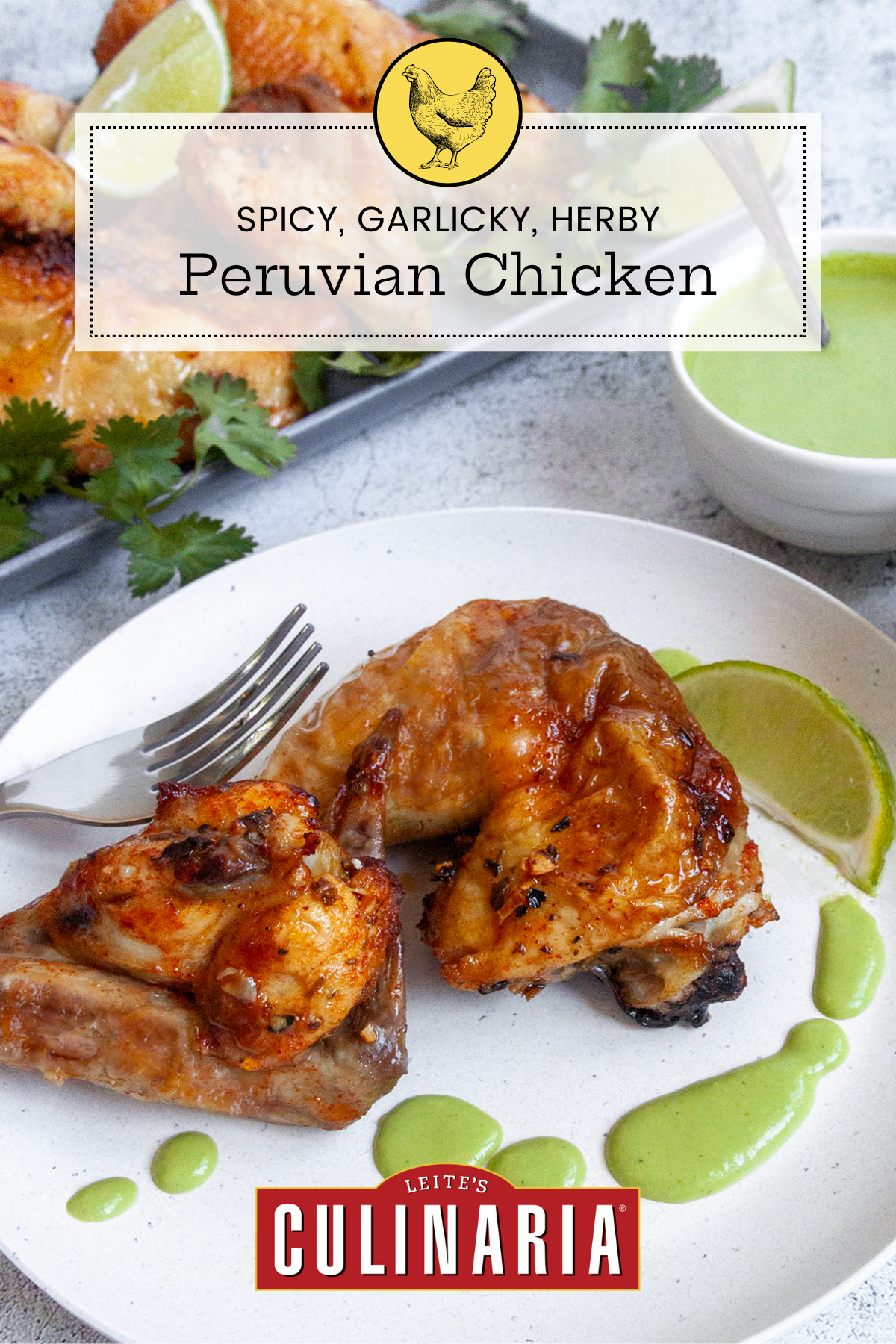
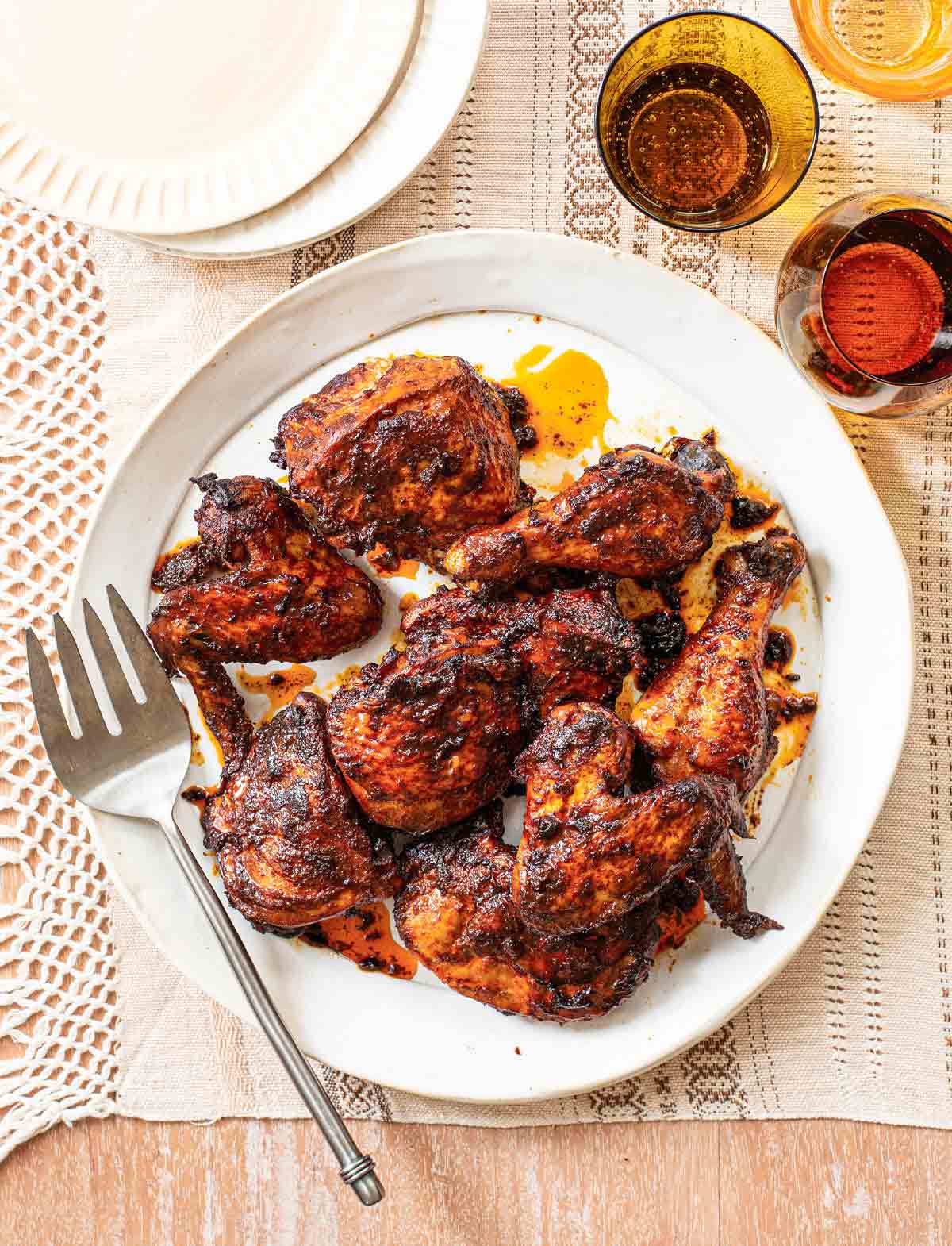
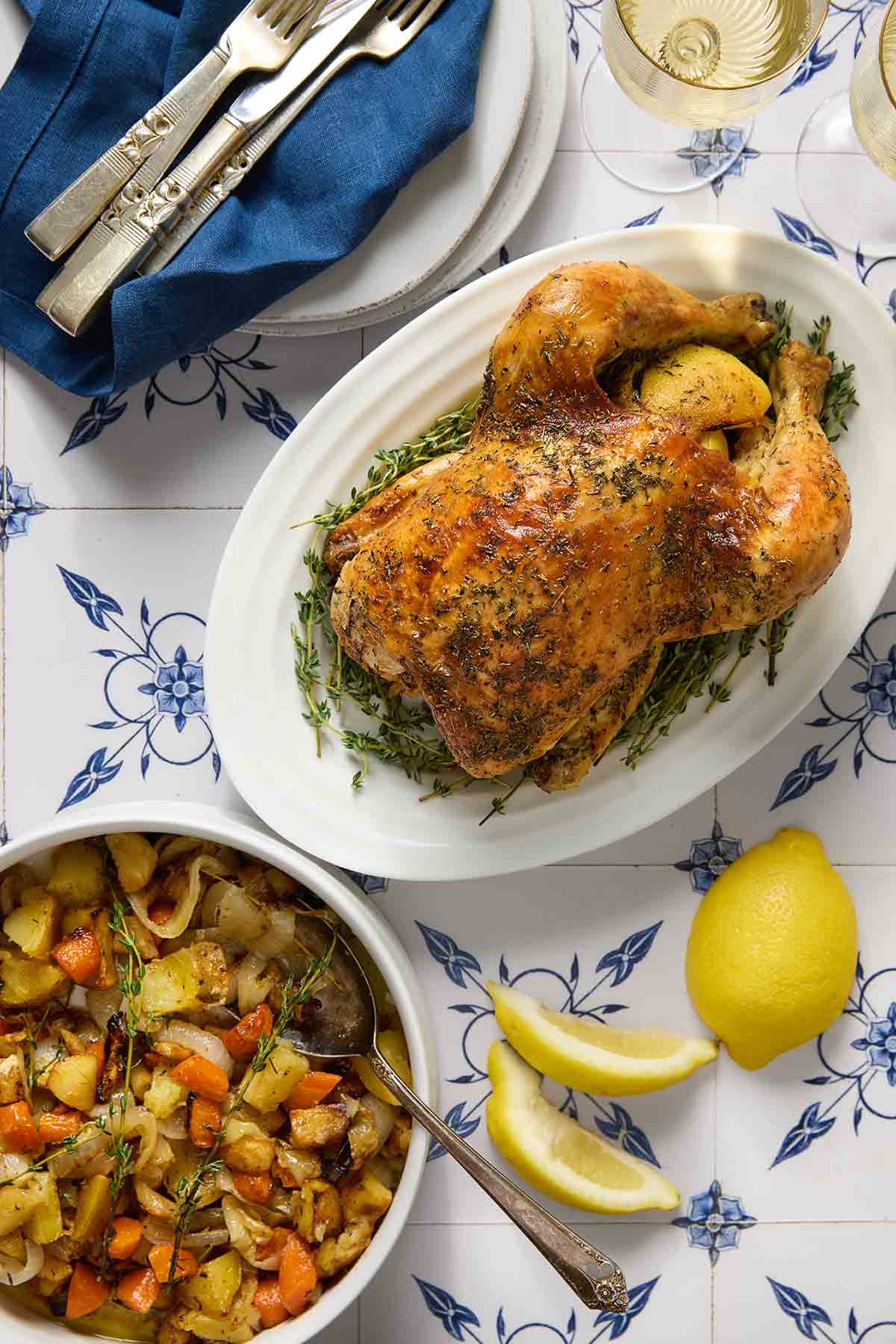














I haven’t tried this recipe yet because there is not quite as long a line at the Crisp and Juicy on Lee Highway in Northern Virginia and their chicken is way better than Edy’s, they also serve the best yellow sauce ever to go with it.
I recall both those places, Susan. And if I was within driving distance, I’d never bother to attempt homemade pollo a la brasa, either.
I’m going to agree with Renee S. on the cilantro-parsley issue. I can’t quite work my taste buds around parsley in this. Mint and basil are sometimes used in Peru, but I can’t quite make that work in my virtual taste buds, either.
Allow me to float an idea: Would minced tomatillo as a substitute for the cilantro maybe provide the tart, herby notes without the “soap” notes that the cilantro-adverse object to?
The Spice House sells aji amarillo chile powder now, which can be made into a paste by adding a bit of oil to it. It’s worth looking for as the flavor is so much more interesting then jalapeno, IMO. It’s wonderful on roasted potatoes and on eggs, too. (Haven’t tried it on popcorn yet, but only because I can’t stop putting their half-sharp paprika on my popcorn.)
It is a Renee Revolt!
Hey Renee, thanks for the tip about the aji amarillo chile powder! You can also, if you happen to ever be in a Peruvian grocery store, find frozen whole aji amarillo peppers by the bagful. My husband thaws ’em and blends ’em with a mild olive oil and some garlic for a truly spectacular paste, much like yours. And, like you, I adore it on eggs. (Kindred souls?!) It’s a very interesting proposal about the tomatillos. Ilove me a good tomatillo salsa and in fact have some little husked green guys in the fridge right now. If you were just using jalapeño in the green sauce, I would say absolutely toss in some jalapeños. But for some reason I just can’t see it with the aji amarillo…but that may just be me? Also, have you seen the new cookbook Peru by chef Gastón Acurio? Something tells me you’d really like it. Unlike most Peruvian cookbooks I’ve seen, he doesn’t go crazy in turning the traditional into something chimerical. He just sorta does things as they were meant to be.
Everyone loves-loves-loves cilantro, but I’m one of those pitiable creatures who can’t appreciate it (according to a story on NPR, I’m lacking one of the olfactory sensors necessary to distinguish its flavor from soap). So … the chicken sounds and looks luscious, but what about the sauce? Would substituting parsley for the cilantro be a good move? Or can anyone suggest an entirely different sauce that would go with the flavors in the chicken?
Karen, you’re not pitiable–maybe, not enviable. I adore cilantro, The One not so much. I think parsley would be a perfectly fine substitute. You can even use parsley for the bulk of the herbs, and round it out with others. Won’t make or break it.
Actually, Karen, I’m going to trump David here and caution against substituting parsley. I’ve had Peruvian green sauce more times than I can recall (my husband’s mother is from Peru and he loves to try Peruvian restros wherever we go) and I honestly can’t see the flavor of parsley playing terribly nicely with the other ingredients in this sauce. I really think you’d be disappointed, not because it’s not authentic but because the flavors may just sorta collide with one another forcefully. If you try it, please let me know how it goes! Otherwise, you could perhaps swap a chimichurri or your other fave green sauce for this. I’ve often swapped parsley for cilantro in salads, frittatas, marinades, and the like, but with the particular combination of ingredients, I just don’t think it’s a go.
I just roasted 2 chickens following the Peruvian Chicken recipe recently posted. It’s a very good recipe. Frankly I am a BIG fan of the one you posted a few years back…but I digress.
I am very sympathetic to the lady who thinks cilantro tastes like soap. Living in Santa Fe where this ingredient is fairly common, I run into people who don’t like it more often than chefs in other areas might.
I have had success in substituting pickles for cilantro–cornichons. I got the idea from Marcella Hazan’s Essentials of Italian Cooking. I Love salsa verde and she has a version with pickles or cucumber. I happened to have both in the house this morning, so I made a batch of the sauce with the pickles and a batch with English seedless cucumbers. I would have difficulty choosing between the two and the cilantro non tasters among us will not be offended. Like Ms. Rossi, I object to the substitution of parsley for cilantro. I don’t think it’s a good swap…especially in recipes with cumin.
So, sorry David, but try the pickles or cucumbers.
Chef Diane Perkins
Santa Fe
Chef Diane, this is perfect and lovely. Many, many kind thanks for tipping us off to this brilliant trick!